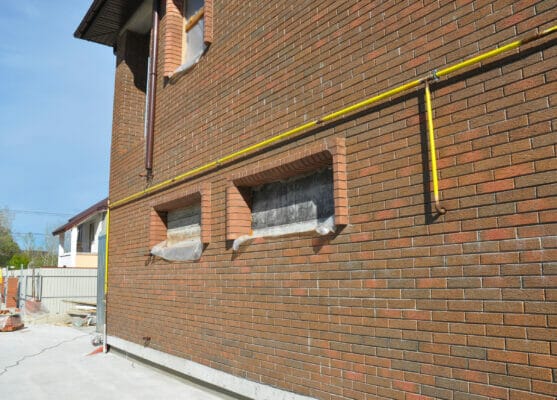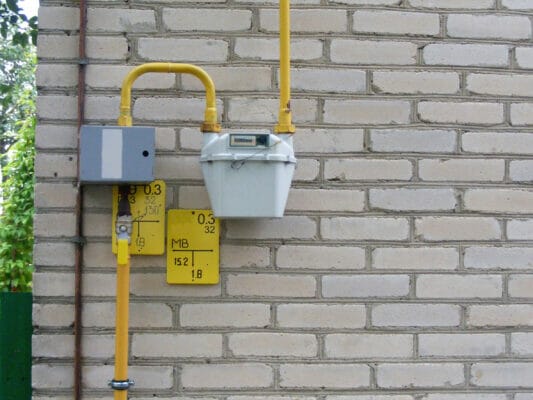Disclaimer: This post may contain affiliate links, meaning we get a small commission if you make a purchase through our links, at no cost to you. For more information, please visit our Disclaimer Page.
You run a gas line through an outside wall by installing the right pipe size, couplings, and fittings. You may also need a threaded rod with a galvanized hanger if you need to hang the pipes. Measure everything to avoid leaks and test for leaks as well.

Table of Contents
Can you run a gas line on the exterior wall?
Building department officials from different cities and counties have different thoughts about running a gas line on an exterior wall. Some allow you to run it on the exterior wall, while some do not allow it. So the best answer to this question is to inquire about the codes required by the county or city you live in.
But in general, gas lines can be exposed on the exterior wall. It does not pose any danger to the community.
If you are lucky to live in a community where you run a gas line on an exterior wall, you must take note of the good piping practices, right pipe materials, and other rules implemented in the installation of the gas line.
At this point, I’ll give you the standard rules that most building department officials agree to implement. It does not matter if they allow you to run your gas line on an exterior wall or not. These rules are implemented across the country to provide safety for homeowners.
One of the standard rules is keeping the piping in protected areas. Even though the gas line is exposed, you must ensure that it is not accessible to everyone. It must not be located in a danger zone area or a location where children can access it.
Upon installation, you must also ensure to secure the pipes. In most cases, strapping the pipe every four feet is safe. You can even strap it lesser than four feet.
Painting the pipe is also needed, even if it is possible to leave the pipes unpainted. Keep in mind that, while some counties and cities permit it, other counties and cities forbid it.
Some authorities, on the other hand, only enable you to paint a specific type of pipe. So you should ask this as well.
How do you run a gas line through an outside wall?
Before we dive into the steps in running a gas line through an outside wall, let me remind you that this is not supposed to be a DIY project. The steps may be simple but hiring a professional gas fitter is important for this project. But for the sake of providing you the information you need, here are the steps.
Turn off the gas
Before you start the installation, do not forget to turn off the gas. You do not want to blow up your house because of the gas leaks. Use a wrench to ensure that it is tightly closed. When you are ready to assemble the pipes, disconnect the drip cap.
Prepare the pipes and fittings
Installation of a gas line requires several materials to connect each component before it reaches the outside wall. You need the right size and length of pipes to avoid leakage. Everything must be connected tightly.
The hardware store offers long pipes that measure 21 inches but it requires you to cut and thread when it is too long. If you do not want the extra work, you can buy the pre-cut pipes with increments of one meter to inch from longest to the shortest.
For a DIY job, it can be impractical to buy a lot of pre-cut pipes because you may end up not using everything.
There are three types of pipes available in the market today including copper, corrugated stainless steel tubing (CSST flex), and black iron pipe. The most popular type is the CSST flex because it is easy to install.
You can find brands that are ideal for the outdoors that are resistant to the electrical damaging effects, resistant to lightning effects, and do not require additional bonding.
Black iron pipe is another popular type that most plumbers use. It is durable and is best for outside piping.
You also need a coupling and a pipe joint compound to ensure that the pipes are connected securely. The pipe joint compound is applied to the threads.
If you are hanging the pipes, you will also need a threaded rod with galvanized hanger to keep the pipes in place. If you are connecting the pipes with a hose, you will need a snap connector for hoses. Do not forget to spray paint the steel pipe to avoid rust.
Measure everything
Measure the length of the pipes to avoid leakage. Everything must fit well. To ensure that you get the right measurement, check the area before you buy the pipes. Plan ahead. It guarantees that you will not commit mistakes during the installation.
Test it
Test the pipes before connecting them to your appliance. Two tests must be performed: a soap test and a pressure test with a gas pressure tester. These tests determine whether or not the pipes have holes.
A soap test requires you to spray a solution of liquid soap on the connections. You will know if there is a leak when big bubbles show up.
On the other hand, the pressure tester is attached to the pipe where you leave it for several hours. When the pressure goes down to zero, a possible connection error is made during the installation.

How do you run a gas line outside?
The step-by-step process you learned earlier is the same process you must follow whether you are installing a gas line inside or outside your house. But what I missed mentioning is the safety tips you must keep in mind when installing a gas line.
Use wall sleeves
The first tip that you must remember is when the pipes pass through the wall, you must ensure that the lines at each point run through the sealed wall sleeves.
When installing the pipes, the sleeve must be sealed internally and unsealed externally. When you do it in this manner, the leaks will move outside instead of moving inside your house.
Using a metallic sleeve guarantees providing steady protection from falling debris. But you can use other materials for the wall sleeves.
Drip leg
You must also ask your gas company if there is a moisture freezing problem in your location. If this is the case, you may need a drip leg near the area where the pipeline exits the building. A drip leg also catches the sediments from the gas so that the gas stays pure when it gets into the appliance.
Pipe joint compound
Never use a thread seal tape for steel gas piping. The pipe threads may still have cutting oils that can prevent the sealing of the tape. Instead, use the paste-like material pipe joint compound to keep the pipes intact.
Shut-off valves
Some professional gas fitters may not put shut-off valves within the pipeline. But I suggest that you request your gas fitters to keep the pipeline more secure.
Conclusion
Although it is tempting to install the gas line by yourself, I highly recommend not to take that path. But it does not mean that you need to forget how to do it. A little know-how helps in probing sensible questions to a professional gas fitter.
But if there is one important thing before starting this project is to ask your county or city officials about the policy they implement for the installation of the gas line. You can avoid paying the penalty and installing the gas line if you ask them beforehand. Asking them can save you a lot of money.
